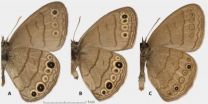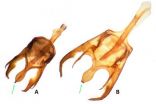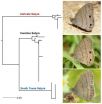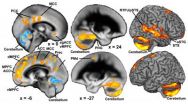(Press-News.org) Butterflies are probably best-loved insects. As such, they are relatively well studied, especially in the United States. Eastern parts of the country are explored most thoroughly. First eastern US butterfly species were described by the father of modern taxonomy Carl Linnaeus himself, over 250 years ago. For the last two and a half centuries, naturalists have been cataloguing species diversity of eastern butterflies, and every nook and cranny has been searched. Some even say that we learned everything there is to know about taxonomy of these butterflies.
Discovery of a new eastern USA butterfly species is indeed very rare nowadays. It is even more remarkable that Texas researchers discovered not just one, but two new species at once. 'It was completely unexpected', said Dr. Grishin. 'We were studying genetics of these butterflies and noticed something very odd. Butterflies looked indistinguishable, were flying together at the same place on the same day, but their DNA molecules were very different from each other. We thought there was some kind of mistake in our experiments.'
But there was no mistake. Segments of DNA sequences obtained from these butterflies, clustered in two groups. While wing patterns in the two groups were indeed very similar, inspection of genitalia revealed profound differences. Males and females from one cluster had larger and paler genitalia, and males and females from the other cluster possessed smaller and darker genitalia, among other numerous distinctions. It became clear that the researchers were dealing with two species, which were not even very closely related to each other, just very similar in wing patterns. The study was published in the open access journal ZooKeys.
One of these species is a well-known Carolina Satyr (Hermeuptychia sosybius), discovered two centuries ago, in 1793: a small brown butterfly, just over an inch in wingspan, with eyespots along the edge of wings. It is one of the most common eastern US butterflies and a usual denizen of shaded, wooded areas, hence the name. The other species was new. It was named "Intricate Satyr" (Hermeuptychia intricata) for 'the difficulty in recognizing this very distinct species and its intricate ventral wing patterns', Cong & Grishin write. Initially discovered in Brazos Bend State Park in East Texas, Intricate Satyr is widely distributed all over eastern USA in several states, including Florida and South Carolina.
One discovery leads to another. Being curious about genetic makeup of these Satyrs, Cong & Grishin decided to investigate DNA sequences and genitalia of Satyr populations from South Texas. And it immediately paid off. These populations turned out to be another new species, named "South Texas Satyr" (Hermeuptychia hermybius). Interestingly, South Texas Satyr is a close relative of Carolina Satyr, but Intricate Satyr is rather distant from either of them.
This begs a question about how many more new species of eastern butterflies remain to be discovered and currently hide behind their colourful wings? Nobody really knows, but it is clear that nothing can be further from truth than a statement that there is not much new to be learned about North American butterflies.
INFORMATION:
Original source
Cong Q, Grishin N (2014) A new Hermeuptychia (Lepidoptera, Nymphalidae, Satyrinae) is sympatric and synchronic with H. sosybius in southeast US coastal plains, while another new Hermeuptychia species – not hermes – inhabits south Texas and northeast Mexico. ZooKeys 379 : 43, doi: 10.3897/zookeys.379.6394
Two new butterfly species discovered in eastern USA
2014-02-19
ELSE PRESS RELEASES FROM THIS DATE:
Targeted treatment for ovarian cancer discovered
2014-02-19
Researchers at Women & Infants Hospital of Rhode Island have developed a biologic drug that would prevent the production of a protein known to allow ovarian cancer cells to grow aggressively while being resistant to chemotherapy. This would improve treatment and survival rates for some women.
The work coming out of the molecular therapeutic laboratory directed by Richard G. Moore, MD, entitled "HE4 (WFDC2) gene overexpression promotes ovarian tumor growth" was recently published in the international science journal Scientific Reports, a Nature publishing group.
"We ...
UNH research: Most of us have made best memories by age 25
2014-02-19
DURHAM, N.H. – By the time most people are 25, they have made the most important memories of their lives, according to new research from the University of New Hampshire.
Researchers at UNH have found that when older adults were asked to tell their life stories, they overwhelmingly highlighted the central influence of life transitions in their memories. Many of these transitions, such as marriage and having children, occurred early in life.
"When people look back over their lives and recount their most important memories, most divide their life stories into chapters ...
How stick insects honed friction to grip without sticking
2014-02-19
When they're not hanging upside down, stick insects don't need to stick. In fact, when moving upright, sticking would be a hindrance: so much extra effort required to 'unstick' again with every step.
Latest research from Cambridge's Department of Zoology shows that stick insects have specialised pads on their legs designed to produce large amounts of friction with very little pressure. When upright, stick insects aren't sticking at all, but harnessing powerful friction to ensure they grip firmly without the need to unglue themselves from the ground when they move. ...
Addicted to tanning?
2014-02-19
BOWLING GREEN, O.—They keep tanning, even after turning a deep brown and experiencing some of the negative consequences. Skin cancer is among the most common, preventable types of the disease, yet many continue to tan to excess.
Research from Lisham Ashrafioun, a Bowling Green State University Ph.D. student in psychology, and Dr. Erin Bonar, an assistant professor of psychiatry at the University of Michigan Addiction Research Center and a BGSU alumna, shows that some who engage in excessive tanning may also be suffering from obsessive-compulsive (OCD) and body dysmorphic ...
A forgotten model of the universe
2014-02-19
A paper published in EPJ H provides the first English translation and an analysis of one of Albert Einstein's little-known papers, "On the cosmological problem of the general theory of relativity." Published in 1931, it features a forgotten model of the universe, while refuting Einstein's own earlier static model of 1917. In this paper, Einstein introduces a cosmic model in which the universe undergoes an expansion followed by a contraction. This interpretation contrasts with the monotonically expanding universe of the widely known Einstein-de Sitter model of 1932.
The ...
Family problems experienced in childhood and adolescence affect brain development
2014-02-19
New research has revealed that exposure to common family problems during childhood and early adolescence affects brain development, which could lead to mental health issues in later life.
The study led by Dr Nicholas Walsh, lecturer in developmental psychology at the University of East Anglia (UEA), used brain imaging technology to scan teenagers aged 17-19. It found that those who experienced mild to moderate family difficulties between birth and 11 years of age had developed a smaller cerebellum, an area of the brain associated with skill learning, stress regulation ...
Minor added benefit of indacaterol/glycopyrronium in COPD
2014-02-19
The drug combination indacaterol/glycopyrronium (trade name: Ultibro Breezhaler, Xoterna Breezhaler) has been approved since September 2013 for adults with chronic obstructive pulmonary disease (COPD). In an early benefit assessment pursuant to the Act on the Reform of the Market for Medicinal Products (AMNOG), the German Institute for Quality and Efficiency in Health Care (IQWiG) examined whether this drug combination offers an added benefit over the appropriate comparator therapy.
According to the findings, the drug combination is better at relieving breathing difficulties ...
Afatinib: Added benefit depends on mutation status
2014-02-19
Afatinib (trade name: GIOTRIF) has been approved in Germany since September 2013 for the treatment of adult patients with locally advanced or metastatic non-small cell lung cancer (NSCLC) with activating EGF receptor mutations who have not been treated with an EGF receptor tyrosine-kinase inhibitor (EGFR TKI). In an early benefit assessment pursuant to the Act on the Reform of the Market for Medicinal Products (AMNOG), the German Institute for Quality and Efficiency in Health Care (IQWiG) examined whether this new drug offers an added benefit over the appropriate comparator ...
Scientists identify 'long distance scanner' for DNA damage
2014-02-19
Scientists at the University of Bristol have discovered that a mechanism for preventing mutation within important genes involves long distance scanning of DNA by a molecular motor protein.
The results, published in the Proceedings of the National Academy of Sciences (PNAS), show that the method for detecting DNA damage within active genes is more sophisticated than previously thought.
The research team hope that the mechanistic insights provided by this study will help to explain the complicated genome-wide patterns of mutation that underlie the evolution of new species, ...
The nose knows in asthma
2014-02-19
It has become increasingly clear in recent years that asthma comes in several variations, with different causes, different pathologies and different responses to therapy. These subtypes of asthma can be identified by knowing which genes are expressed at higher and lower levels in patients' airways. That information can, in turn, help guide personalized treatment to more effectively manage asthma and inspire research to better understand, manage, and possibly prevent asthma.
The difficulty is that tissue samples necessary for this kind of genetic profiling are currently ...




